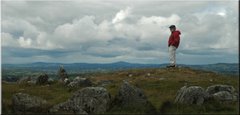German Guns, Easter Rising, and Tradition of Holocaust
Today is Easter, 2007. 91 Easters ago, a supremely futile act took place in Dublin. Called the "Easter Rising," it was a knowingly-doomed act of armed rebellion against England by a small group of intense patriots who managed to sieze Dublin's post office (and a biscuit factory) before being squashed, captured, and hastily executed by British troops in brutal fashion. The Easter Rising became Ireland's modern Alamo (in an American reference frame): a rallying cry, a symbol, a rock of resolve for the ultimately successful but wrenching detatchment from the UK that would follow in the next decade.
The rebels were not entirely suicidal, however. They knew that they needed firearms to have any chance of success (however defined), and pre-WWI Germany seemed a likely source. A yachtload of guns for them from Germany made its way to Howth harbour (on the northeast entry of the bay on which Dublin and the mouth of the River Liffey lie) on the 26th of July, 1914. The story of those guns, and of Erskine Childers, can be found by clicking on this link.
The rebels were not entirely suicidal, however. They knew that they needed firearms to have any chance of success (however defined), and pre-WWI Germany seemed a likely source. A yachtload of guns for them from Germany made its way to Howth harbour (on the northeast entry of the bay on which Dublin and the mouth of the River Liffey lie) on the 26th of July, 1914. The story of those guns, and of Erskine Childers, can be found by clicking on this link.
 Diane Harrington at the Howth harbour lighthouse, July, 2006. (Photo by S. Harrington)
Diane Harrington at the Howth harbour lighthouse, July, 2006. (Photo by S. Harrington)Just to the right of the lighthouse in the above fame is a plaque commemorating the 1914 gun-running adventure. I wish I had thought to photograph it, but didn't. It can be seen, though, in the top photo, halfway to the right of the frame from the lighthouse.
... and some of those guns are probably still wrapped in oilcloth and stashed carefully in cellars or caves, against their necessary use, which some if not most feel will be inevitable for some reason or another. That's just what they do.]
The small, lovely island of Ireland has an unrelenting history of brutality of humans upon one another. The Easter Rising was just one of the most recent manifestations of that sad legacy. The island's brutal history's most recent underlying theme has been that of Protestant vs. Catholic, but others preceded that.
The current division, though, seems -- maybe, maybe, please God, possibly -- to be coming to an end. The most implacable leaders of the opposing sides last week actually sat down to a jovial chat in Dublin, something that just staggers anyone who has been paying attention for the last, oh, 30 years or so.
And it had best work, and it had best last. Because ghastly murder on an industrial scale has always been the outcome when it doesn't.
One of Ireland's major tourist attractions is the "Rock of Cashel":
 Southwestern corner of the Rock of Cashel, August, 2006 (Photo by S. Harrington)
Southwestern corner of the Rock of Cashel, August, 2006 (Photo by S. Harrington)Cashel is a town in mid-Tipperary, on the southern side of the grand Tipperary plain, and just north of the Galty Mountains and the Cahir pass. On the town's northeastern edge is a little nubbin of an outcrop of rock, perhaps a hundred feet tall and a couple of acres in extent. This rocky prominence provides a logical place for a fortress.
 The Rock of Cashel from the northern (less-photographed) side. (Photo by S. Harrington, August, 2006)
The Rock of Cashel from the northern (less-photographed) side. (Photo by S. Harrington, August, 2006)Please click on any photo to see a larger version.
 The Rock of Cashel, August, 2006 (photo by S. Harrington)
The Rock of Cashel, August, 2006 (photo by S. Harrington)The top of the rock outcropping was built up intensely after St. Patrick converted most of the island's people to Catholicism in the first millennium AD. Multiple Catholic Christian structures adorn the outcrop, including a mammoth cathedral, built in the mid-1200's.
 From left to right: Cathedral wall, modern gravestone, Cormac's Chapel wall. A church spire in the modern town of Cashel can be seen to the left of the grave cross. (Photo by S. Harrington, 2006)
From left to right: Cathedral wall, modern gravestone, Cormac's Chapel wall. A church spire in the modern town of Cashel can be seen to the left of the grave cross. (Photo by S. Harrington, 2006) Different architectural styles crowd up against one another on the rock. Here, the rude but mammoth cathedral (left) squeezes against the more refined (but older) Cormac's Chapel. (Photo by S. Harrington, 2006)
Different architectural styles crowd up against one another on the rock. Here, the rude but mammoth cathedral (left) squeezes against the more refined (but older) Cormac's Chapel. (Photo by S. Harrington, 2006)During the Cromwellian subjugation of Ireland in the 1600's, Murrough O'Brien, Lord Inchiquinn (later, for clear reason, dubbed "Murrough the Burner"), commanded the British attack on Cashel. Townspeople and Catholic clergy took refuge in the huge Cathedral on the rock in the summer of 1647, only 360 years ago.
 The center of the Cathedral's great cross. (Photograph by S. Harrington, 2006)
The center of the Cathedral's great cross. (Photograph by S. Harrington, 2006)How many people sought refuge in the Cathedral is not known exactly, but estimates range up to 3,000. Given the huge size of the Cathedral's ruin, the latter number is not at all inconceivable.
 The square holes are all that is left of great beams which supported interior floors and walls within the Cathedral. (Photograph by S. Harrington, August, 2006)
The square holes are all that is left of great beams which supported interior floors and walls within the Cathedral. (Photograph by S. Harrington, August, 2006)Once the townspeople and the clergy were crowded into the Cathedral on top of the rock, Inchiquinn's forces piled peat bricks, confiscated from the town's houses, all around the base of the structure. (Peat was [and, in many places, still is] the fuel for fireplaces and cooking in Ireland.)
 Once the peat was in place, it was set afire. All within the structure were killed, either by fire, or by smoke, or by collapse of the wooden structures above them. How many died is not known. You can Google numbers from a few hundred to three thousand. The latter number -- roughly equivalent to the number of Americans killed in the terrorist attacks of 9/11/2001 -- may be unreasonably large, but still possible -- and in a land of far fewer people to start with.
Once the peat was in place, it was set afire. All within the structure were killed, either by fire, or by smoke, or by collapse of the wooden structures above them. How many died is not known. You can Google numbers from a few hundred to three thousand. The latter number -- roughly equivalent to the number of Americans killed in the terrorist attacks of 9/11/2001 -- may be unreasonably large, but still possible -- and in a land of far fewer people to start with.But any deficit of corpses would be easily made up in the subsequent centuries. That a land of such aching beauty in a tiny area should also be one of ghastly inhumanity is a contrast of unfathomable dimension. Current optimism is well-taken, but I agree with Mike Peterson when he writes that "the urge [in Ireland] to bury guns against the day when you need to
dig them up again must be overwhelming..."
It's not over, and it may never be.





No comments:
Post a Comment